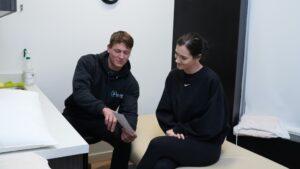Low back pain affects people of all ages and backgrounds. Whether you lead a sedentary lifestyle working long hours at a desk or engage in physically demanding activities, understanding the causes of low back pain and adopting preventive measures can significantly improve your overall well-being.
In this post, we explore the causes of low back pain, tools to prevent lower back pain, and offer three exercises targeted to alleviate lower back discomfort.
Causes of Low Back Pain
- Poor Posture: One of the leading causes of low back pain is poor posture, especially in activities that involve prolonged sitting or standing. Slouching or maintaining an improper spinal alignment can strain the muscles and ligaments in the lower back, leading to pain, spinal stenosis, acute low back pain, nerve pain, radicular pain, and more.
- Muscle Strain: Overuse, repetitive movements, or sudden strenuous activities can cause muscle strain or muscle spasm in the lumbar spine. This lower back pain is common among individuals who lift heavy objects without proper form or engage in activities that put excessive stress on the lower back.
- Sedentary Lifestyle: Lack of physical activity and a sedentary lifestyle can weaken the muscles that support the spine. Weak core muscles, in particular, contribute to poor spinal stability and increase the risk of developing low back pain.
- Degenerative Conditions: Conditions such as herniated discs, arthritis (specifically axial spondyloarthritis), and spinal stenosis can contribute to your low back pain. These degenerative changes affect the structure of the spine and may lead to nerve compression, resulting in discomfort.
What You Can Do
- Maintain Good Posture: Be mindful of your posture! This is such an important tip to properly manage your lower back pain—especially when sitting for extended periods. Use ergonomic chairs and desks to support a neutral spine position. Take breaks to stand, stretch, and walk around to prevent stiffness and muscle imbalances.
- Stay Active: Engage in regular physical activity to strengthen the muscles that support your spine. Incorporate exercises that target the core, back, and hips to support your spinal column and spinal canal. Activities such as swimming, walking, and yoga can be effective in promoting flexibility and strength.
- Lift Properly: When lifting objects, bend your knees and keep your back straight. Avoid bending at the waist, as this puts excessive stress on the lower back. When heavy lifting it’s vital to use your legs to lift. If the object is too heavy you risk a compression fracture, sciatic nerve discomfort, cauda equina syndrome, spinal nerve pain, acute back pain, and more. Always ask for assistance!
Preventive Low Back Pain Exercises:
Pelvic Tilts:
- Lie on your back with knees bent and feet flat on the floor.
- Tighten your abdominal muscles and press your lower back into the floor.
- Hold for a few seconds, then relax.
- Repeat 10-15 times.
Bird-Dog Exercise:
- Start on your hands and knees in a tabletop position.
- Extend your right arm forward and left leg backward, keeping your back straight.
- Hold for a few seconds, then return to the starting position.
- Repeat on the opposite side.
- Perform 10 reps on each side.
Bridge Exercise:
- Lie on your back with knees bent and feet flat on the floor.
- Lift your hips off the ground, creating a straight line from shoulders to knees.
- Squeeze your glutes and hold for a few seconds.
- Lower your hips back to the ground.
- Repeat 10-15 times.
Manage your Chronic Back Pain at Synergy Rehab
Understanding the causes of your lumbar spine pain and taking proactive steps to prevent it can make a significant difference in your overall spinal health. Incorporating regular physical therapy exercises that strengthen and stabilize the muscles supporting your lower back, along with adopting good posture, regular physical activity, and proper lifting can contribute to a healthier and pain-free lifestyle.
If you’re experiencing chronic low back pain make sure to visit your local physical therapist. Our sports medicine specialists can offer pain relief for chronic pain through personalized advice and treatment.









